Airmen have been at war in Afghanistan since Oct. 7, 2001. Few would have imagined then that the war would be the major issue for a new President in 2009, more than seven years later. But it is.
“I want the American people to understand that we have a clear and focused goal: to disrupt, dismantle, and defeat al Qaeda in Pakistan and Afghanistan, and to prevent their return to either country in the future,” said President Obama in announcing a new strategy in March 2009.
In May, Defense Secretary Robert Gates took the unusual step of removing Army Gen. David McKiernan, the top US commander in Afghanistan, thereby providing another indication of how seriously the administration felt a new direction was needed for the war.
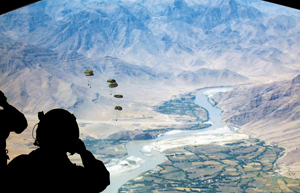 |
SSgt. Derek Howard, a loadmaster with the 816th Expeditionary Airlift Squadron, surveys cargo bundles descending to a drop zone in Afghanistan. |
More US troops will deploy to Afghanistan to beef up the security and stabilization efforts of the NATO-led International Security Assistance Force.
Today’s Afghan war features a revived Taliban plus new insurgent players. Conflict escalated in 2006. Skirmishes with NATO-led forces and terrorist attacks on the Afghan population have put the US objectives of stability and security there at risk.
Ground forces draw the media eye, but to a great extent, airpower defines the art of the possible in Afghanistan. More than 70 expeditionary airfields of various types are now in operation there. From close air support to precision airdrops to resupply ground forces, airpower is the tactical and strategic enabler for this vital and distant war.
It’s not unusual for 60 or more fighters and bombers to patrol Afghanistan every day. Backing them up are tankers, airlift, and the all-important aircraft of ISR—intelligence-surveillance-reconnaissance capabilities.
“There’s nothing quite so comforting as an F-15E with a full bomb load flying over your head if you’re in contact,” said Army Brig. Gen. Mark A. Milley, at the time operating with the 101st Airborne Division near Wardak, Afghanistan. “That makes all the difference in your day.”
From the start, this nation’s Afghanistan strategy has relied on airpower to produce heavy firepower, surveillance, and resupply. New Obama Administration policy directions will refocus US goals on the ground, but airpower remains central to achieving them.
Going Final
The Afghanistan conflict evolved through three distinct phases.
First was the war to unseat the Taliban from controlling the government. This was a short, sharp engagement producing victory in just a little over two months. The air campaign cleared the way: Kabul fell in November 2001 and Hamid Karzai’s provisional government took shape in December.
Phase 2 was already under way by then. The hunt for al Qaeda sites and supporters began with the first weeks of Operation Enduring Freedom and continues today. From 2002 through 2005, this mission dominated. Force levels remained relatively low and casualties were intermittent. The world’s eyes were on Iraq but Taliban, al Qaeda, and other elements were regrouping.
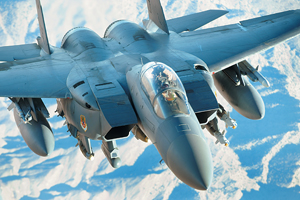 |
An F-15E flies combat patrol over the mountains of Afghanistan |
Phase 3 began in 2005 as the Taliban and other insurgents reasserted leverage over towns and villages, particularly in Afghanistan’s south and east. NATO-led forces fanned out to patrol more contested areas, but their maneuvers stirred up new resistance. US and NATO airmen provided constant fire support, surveillance, and supply drops. Close air support activity shot upward. By July 2008, US Air Forces Central was dispatching more CAS sorties for Afghanistan than for Iraq.
Beginning this year, airmen will participate in the fourth phase of the war in Afghanistan: the search for lasting victory.
The insurgents are not fighting the same fight today as in 2001 or even 2005. The Taliban remain the strongest element. Mixed in are an amalgamation of groups with significant money and support. Poppy cultivation in the south, especially Helmand Province, fuels the insurgency there.
Tactics have changed, too. Maj. Gen. Mart de Kruif, ISAF’s commander for Regional Command South, explained that “two years ago, the insurgents changed their overall strategy from attacking our strength towards focusing on terrorizing the local nationals, the Afghan people.”
Increased use of improvised explosive devices was one result. “For ISAF, that means that we have to deliver a 24/7 security in the focus areas where we are placed,” de Kruif pointed out. “It’s no use getting into a village at 8:00 in the morning and then leaving that village at 5:00 in the evening.”
“Once we start the shape, clear, hold, and build concept in a region, we have to stay there,” said de Kruif. NATO had enough forces to clear parts of central Helmand and central Oruzgan Provinces, he said. However, “to be able to extend these focus areas, we definitely need more troops.”
What hasn’t changed about Afghanistan is the ongoing reliance on airpower to make the fight viable for far-flung forces.
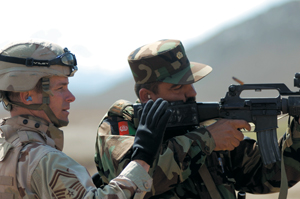 |
SMSgt. Robert Spaulding (l) instructs Capt. Abdul Rahman, an Afghan Military Police commander, during a training session at Kabul Military Training Center, Afghanistan. |
In fact, the challenges of Afghanistan have done much to reshape the combat power of the Air Force. Afghanistan may have done more even than the conflict in Iraq to bring changes in USAF’s combat airpower.
Four lines of change stand out. They are:
- Introducing ISR as an independent variable;
- Providing routine tactical resupply on a nonlinear battlefield;
- Fine-tuning firepower for irregular warfare, and;
- Setting the strategic conditions.
ISR Comes Into Its Own
It was in Afghanistan that the role of ISR took shape as an independent variable in successful air campaign operations. Imagery and electronic intelligence was important from the start. The Global Hawk reconnaissance drone proved its value in shooting thousands of images of developing situations from 2001 onward.
Airmen continually refined ISR as operating conditions changed. ISR tasking for imagery such as full-motion video, for example, most often followed tips from other sources. Ground forces might call in a tip based on human intelligence, or other signals intelligence might provide the cue.
“A ground unit might receive a Humint tip indicating presence of the enemy in a certain location,” an ISR expert, Lt. Col. Michael L. Downs, wrote in the fall 2008 issue of the Air Force’s official Air and Space Power Journal. To confirm the tip, a battalion may request ISR support to locate that activity. Tips often gave the imagery platform a better shot at finding the item of concern. Hence, the increased activity of ground forces tended to generate an upswing in requests to survey particular areas.
Aerial resupply has become another signature achievement of the Afghanistan war. The changes at the tactical level began in 2006 just as the conflict was moving into its third phase.
“We were doing a lot of [cargo drops] within anti-aircraft artillery and small-arms range,” said Lt. Gen. Gary L. North, AFCENT commander. Aircraft sometimes took hits, and the threat was growing. North urged Air Mobility Command to speed up the delivery of the Joint Precision Airdrop System to the theater to enable satellite guided resupply.
The first combat JPADS drop took place from a C-130 on Aug. 31, 2006.
For airmen, JPADS improves survivability by permitting higher altitude airdrops above many types of ground fire. Accuracy is excellent—cargo typically landed in “an area the size of a football field,” said North in an interview.
C-17s began making combined JPADS and Screamer (steerable GPS-guided container delivery system) drops in May 2007.
“The system was amazing to watch,” said SSgt. Derek Howard, an evaluator loadmaster. “When the bundles departed the aircraft and the chutes deployed, you could instantly see them turning in what appeared to be a formation as the guidance system began steering the bundle directly over the drop zone.”
Land forces responded favorably. JPADS “has saved soldiers’ lives [by] offsetting ground convoy requirements and reducing rotary wing sorties intended for airdrop operations,” an official Army statement acknowledged.
Of Afghanistan’s 70-some airfields, only a few—such as Bagram—are major hubs. Most of them are expeditionary airfields supporting aircraft such as C-130s.
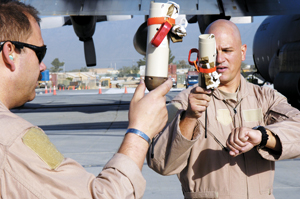 |
MSgt. Gordy Heinen and TSgt. Steven Hayes check dropsondes before a test of the Screamer Joint Precision Airdrop System. |
The growing number of airfields has greatly increased tactical flexibility. Army doctrine has long speculated about a dispersed, nonlinear battlespace. In Afghanistan, the network of forward operating bases has already created that type of war. Dispersed operations deliberately place heavier demands on resupply by air, and the air component closely monitors the location and status of land forces.
Soldiers and marines at the firebases can also call for quick-response tactical airdrops. Air planners pre-position pallets with supplies ranging from water and blood units to ammunition. Aircraft are assigned to sit alert, much like the system for close air support. When a call for immediate supplies comes in, aircraft can be loaded and on their way to the drop zone in under an hour.
Answering the Call
Rapid response also helps move wounded troops quickly. Helicopters pick up many of the wounded in Afghanistan. Top priority is to move them to the hospital at Balad in Iraq. Wounded who reach Balad average better than a 90 percent survival rate. The air component has been known to use everything from C-17s to KC-135 tankers for fast medical evacuation from Bagram.
Now, with Afghanistan’s troop numbers expanding, airmen have been conducting advance airdrops to build up supplies of materials such as lumber.
The next phase of operations will create even greater dependence on strategic airlift. Negotiations for new land routes primarily cover nonlethal equipment such as food, water, and spare parts. US Transportation Command airlifts in weapons, munitions, and essential vehicles such as MRAP (mine-resistant, ambush-protected) trucks.
Raw kinetic data from the air war tell the evolving story of the tactical and strategic dependence on airpower.
US airmen and coalition partners flew 19,603 close air support sorties over Afghanistan in 2008. That was more than a thousand sorties over the 18,423 they flew over Iraq.
Given the smaller number of forces in Afghanistan, the switch was testament to the urgency of the campaign.
“We can help people in a number of different ways, not necessarily dropping weapons,” commented one RAF Harrier pilot based at Kandahar Air Base. Fighters and bombers flew 2,740 shows of force, and responded to 3,630 troops in contact situations.
“If they’re smart, they’ll go away,” said Air Force Capt. Vanessa Mahan, an F-15E weapon systems officer deployed to Bagram.
What the data reveal is just how carefully airmen can rheostat their effects to fit the requirements of controllers on the ground.
Every aircrew shares a common goal: getting to the joint terminal attack controller fast enough to fill the request.
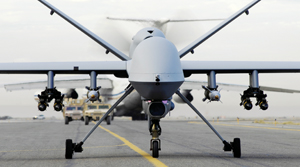 |
|
The process begins by tapping into shared tactical data. Alert aircraft such as the A-10 and F-15E can begin building a tactical picture as they warm up their engines. Fighters and bombers airborne tap into the same picture. The tactical data they access can include links from ISR assets such as Predator and direct communication with JTACs on the ground.
The JTACs themselves are assigned to all maneuver forces—sometimes they carry out dismounted patrols; at other times, they are assigned to tactical operations centers where they can control strikes for multiple patrols at once.
Many missions disrupt or deter terrorist operations. Take the example of IEDs. The use of improvised explosive devices soared after 2007. Most of them are aimed indiscriminately at the Afghan population. ISAF regional commander de Kruif confirmed that IEDs in Afghanistan are most commonly detonated by a pressure plate.
Aircraft orbiting overhead have been able to monitor and break up attempts by insurgents to place IEDs.
Airpower has also provided the “armed overwatch” essential to road movement through contested areas. The airpower shield is an integral part of today’s small-unit tactics. For example, in March, coalition aircraft launched a 500-pound laser guided bomb at insurgents who were attempting to place IEDs near the Kajaki Dam—a major reconstruction project. The bomb blast caught all but one insurgent. That lone squirter was taken down by strafing fire.
On the same day, aircraft were called to break up enemy small units preparing an attack near Nangalam. According to North, better cueing of ISR assets has resulted in strikes before hostile forces can attack.
According to the day’s official summary, F-15Es took out multiple enemy fighting positions and destroyed several heavy machine gun nests during the engagement. The Strike Eagles followed up with attacks targeting enemy gunmen trying to escape into the mountains.
What do soldiers in Afghanistan feel when aircraft show up? “Relief,” said Army SSgt. Adam Kern. “You know it’s going to be over.”
The roar of friendly aircraft overhead can bring about a quick change of emotions for friendly ground troops. “When [the aircraft] came on station and started doing their gun runs, you went from a feeling of ‘I’m dead’ to ‘Look at them run,’” Kern said.
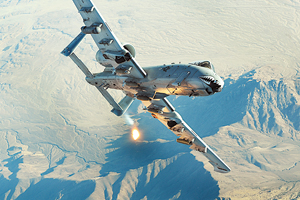 |
An A-10 from the 75th Expeditionary Fighter Squadron, Bagram AB, Afghanistan, drops flares during a combat patrol over Afghanistan. |
There are now several air units based in Afghanistan. Bagram hosts A-10s, F-15Es, and coalition aircraft. Kandahar has also become a major operating base for strike aircraft. Close air support aircraft sit alert as well as patrol the skies.
The maintainers realize the importance of keeping jet aircraft ready to go at a moment’s notice. “If there’s anything that needs to be done, you want to know within the first couple of minutes of landing, because this jet might be asked to go up again in an hour,” said SSgt. Brandon O’Neal.
All this airpower has clearly benefited from benign airspace. For nearly all of the Afghanistan war, there have been few threats to aircrews, which enables constant overwatch and support. However, the environment has never been completely free of threats. Enemy forces in Afghanistan are also trying harder to shoot back at aircraft. Helicopters have been particularly vulnerable.
Mass Matters
NATO statistics noted a rise in sporadic attempts at surface-to-air fires (often abbreviated SAFire) in 2007 and 2008.
Airlifters and fighters are at risk when they go low. The low-altitude threat from small arms and shoulder-fired guided weapons is hard to eradicate and can never be counted out completely.
Potential threats include rocket-propelled grenades and shoulder-fired surface-to-air missiles. Takeoffs and landings can be hazardous, as can flying low for a show of force—an important tactic. “It tells the insurgents that there’s close air support out there,” said an RAF pilot interviewed for the British television network ITV Central.
Beyond this, air base security remains a constant priority. Insurgents have attacked airfields with mortars and suicide bombers on several occasions.
The nature of the mission has even opened the door for new threats. Low-flying helicopters, cargo airdrops, and even fighters on strafing missions are enticing targets.
Despite the length and innovation of the conflict, it’s hard to say how much impact it will have on the canon of American strategic thinking. Surprisingly little has been written about operations in Afghanistan in the professional military journals. Many of the most exciting titles date to the 1980s when analysis of the USSR’s slow failure there made for compelling reading. In contrast, the shifts in US capabilities in this decade are underdocumented.
Part of the reason for the dearth of professional military writing may be that while tactics are constantly being refined, the strategic fundamentals of military operations in Afghanistan were set at the outset. It is a war where maximizing airpower is essential at the tactical and strategic level. The air coverage allowed commanders to mitigate risk and put in play a relatively small number of lightly armed forces.
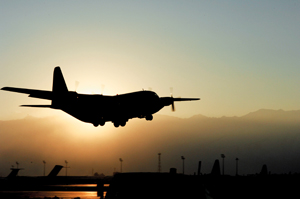 |
A C-130 lands at Bagram Airfield. C-130s take off and land at most of Afghanistan’s expeditionary airfields. |
Several attempts by the Taliban to draw coalition forces into set-piece land battles between 2001 and 2006 were squashed by airpower. Insurgent forces cannot defeat airpower when it is combined with smart tactics on the ground.
Airpower did not make US, coalition, or Afghan forces invulnerable. What it did—which would surprise no expert air commander—was to make the offense far more lethal and efficient.
Even with more troops headed to Afghanistan, the nation remains a scene of light ground forces working hand-in-hand with airpower. The unprecedented dependence on airdrops for tactical resupply speaks to the wide margin airpower gives to forces fighting there. In the irregular and dispersed fight, airpower’s asymmetric advantages are tangible.
“It’s a war, and in a war, mass matters,” said Milley, the deputy commander for the sector including Wardak Province. “Over time, this will work—it has worked over and over again through history.”
Whether the need is for massed supplies, massed intelligence, or massed firepower, airpower will offer it in Afghanistan.
Rebecca Grant is a senior fellow of the Lexington Institute and president of IRIS Independent Research. She has written extensively on airpower and serves as director, Mitchell Institute, for AFA. Her most recent article for Air Force Magazine was “The Cyber Menace,” which appeared in the March issue.
